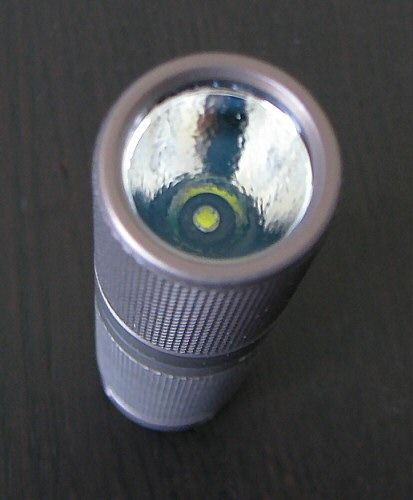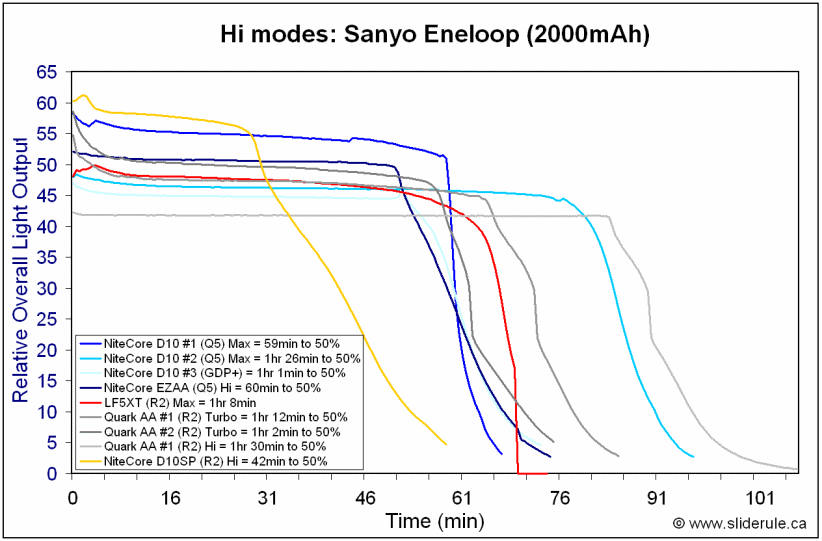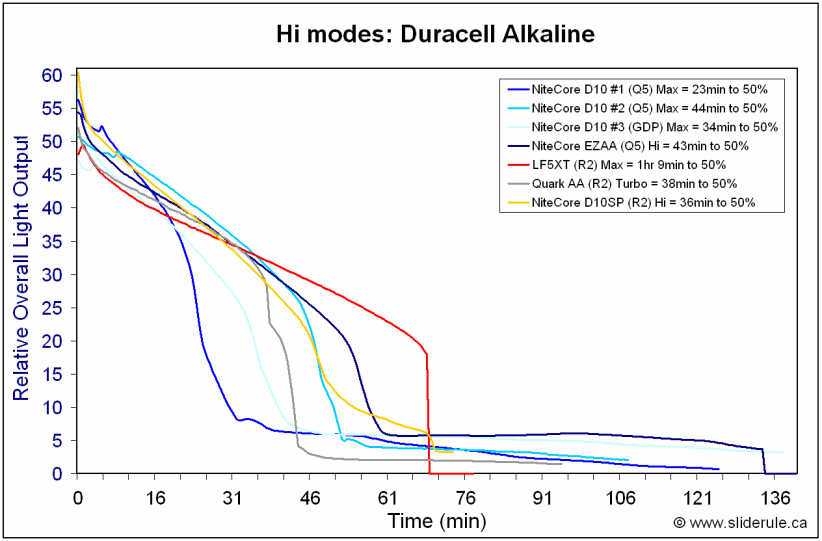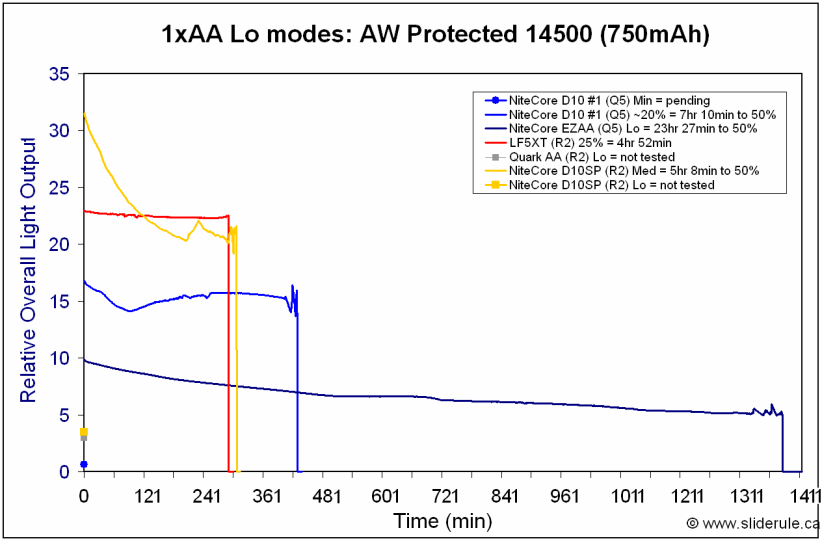Reviewer's Note: The D10SP was provided for review by NiteCore. Please see their website for more info.
Warning: pic heavy, as usual.
Manufacturer's specifications, condensed from their website:

Packaging has been updated, and the light now comes in a longer cardboard box with cardboard/paper insert. Inside comes the light, good quality wrist strap, extra o-rings, pocket clip screws and allen key (though oddly no clip on my sample), warranty card and manual.






From left to right: Duracell AA, NiteCore D10SP, D10 (Q5), NDI (Q5).
D10SP: Weight 45.8g, Length 89.7mm x Width 20.7mm (bezel)
Overall dimensions don't seem any different than the original D10 lights. The hard anodized (type III) finish has changed – the SP has a sandy-brown grey colour, compared to the earlier charcoal-dark grey D10 finish. Machining and anodizing quality remain high on my sample.
Aside from color change, the additional "SP R2" label after the D10 is the only obvious external body difference. Labels are reasonably clear, although I still find them a little small (my eyes must be getting old ).
).
The emitter is of course upgraded – no longer using a Cree XR-E or GDP, these new D10SPs have the now standard Cree XP-E (R2).

Inside is where things begin to change a little. The contact board in the head is a different colour now, and the piston has a greater protruding button-end, where the o-ring is now located. I don't find the press-feel of the light any different, so I'm not clear on the reason for the change (i.e. doesn't really make a difference ergonomically).
The light can still tailstand. :thumbsup:

As before, the light still comes with a textured OP reflector (although the texturing seems a little heavier now). Note the new XP-E emitter.
And now for the requisite white wall hunting … all lights are on Max with on Sanyo Eneloop, about 0.5 meters from a white wall.
… all lights are on Max with on Sanyo Eneloop, about 0.5 meters from a white wall.



Beam pattern is fairly pleasing, without the standard Cree rings of the earlier XR-E model, or the color distortions of the GDP.
Tint is pretty good on my sample, maybe just slightly on the purplish side of premium cool white (of course, YMMV). For those of you not familiar with tint bins, please see my Colour tint comparison and the summary LED tint charts found here.
User Interface
The multi-mode D10SP features a revised interface over the previously continuously-variable original D10.
Now, when you press and hold the piston down, the light rapidly moves through only 3 output modes instead of the previous 100+ continuously-variable ones. Time to cycle through them is now about 2 secs instead of ~8 secs on the older version.
"Shortcuts" no longer jump you to Max (click-press) or Min (click-click) as they did previously on the original D10. On the D10SP, click-press now brings you a strobe mode, and click-click brings you to a SOS mode. Note that these shortcuts are basically toggles – do it again, and you are back to constant output. You can basically consider these as "hidden modes" for regular usage.
The strobe mode is very fast 14Hz.

Light has mode memory, and retains last output setting chosen.
The light can now be locked out – press and hold the switch from off for 1 sec. A brief flash will indicate the light is locked out. To release the lock, do 3 quick flashes. :thumbsup: This circuit feature was not available on the previous D10 versions, and is a welcome addition to allow you to prevent accidental activation.
PWM (Pulse-Width-Modulation)
Although not visible to the naked eye, the light does uses PWM for its low modes, which I dectected at 7.8 kHz on Lo and Med. I also detected a 14.6 kHz signal on Hi, but my system doesn't let me resolve that high a frequency to confirm (it may just be some sort of high freq pulse). Either way, these are excellent PWM freqs.
Testing Method: All my output numbers are relative for my home-made light box setup, a la Quickbeam's flashlightreviews.com method. You can directly compare all my relative output values from different reviews - i.e. an output value of "10" in one graph is the same as "10" in another. All runtimes are done under a cooling fan, except for the extended run Lo/Min modes (i.e. >12 hours) which are done without cooling.
Throw values are the square-root of lux measurements taken at 1 meter from the lens, using a light meter.
Throw/Output Summary Chart:


As expected, max output on Eneloop is a little higher with the R2-equipped D10SP, compared to earlier versions.
Note that the Lo mode is not as low as the previous versions were capable of. :sigh:
Output/Runtime Comparison:









Although hard to compare given the output differences, it seems like the overall efficiency of the SP version is lower at the Max setting (especially on standard batteries - eneloop, L91, alkaline), and higher on the Med setting (especially on 3.7V 14500 Li-ion).
Potential Issues
Build-wise, nothing significant from previous versions. Note that all NiteCore "piston-drive" lights tend to have somewhat stiffer operation than traditional clicky switches.
When in momentary mode, if you depress the switch for more than 0.5secs, you will start cycling through output levels (i.e. effectively, there is no momentary mode as such).
Contrary to specs, the D10SP Lo output is not as low as my earlier D10 lights. According to my lightbox, on Lo the new SP is approximately three times brighter on Eneloop, and five times brighter on 14500. I believe the original D10 was well under 1 lumen on Lo, despite the original 3 lumen spec (the new D10SP's 2 lumen estimate seems reasonably accurate to me).
SOS speed is rather fast (i.e. faster than you would be able to signal in a true momentary light).
Preliminary Observations
The D10SP is basically a revised D10 light that forgoes the continuously-variable ramp in favour of 3 defined output modes and the addition of SOS and strobe modes on the "shortcuts" (i.e. click-press, double-click).
Although there are a couple of minor build updates (i.e. position of the o-ring on the piston, contact surface in the head, new anodizing colour) and a few nice new features (i.e. circuit lock-out option, higher output X-PE emitter with smoother beam pattern), these are really more evolutionary than revolutionary. It is up to you whether you see the addition of strobe and SOS modes (and loss of continuously-variable mode) in the D10SP as an upgrade. :shrug:
Overall efficiency of the D10SP's Hi output appears to have dropped (especially on standard batteries - NiMH/alkaline/L91), but improved on Med mode (at least on 14500). And contrary to the reported specs, the min output of the new SP version is considerably brighter than the min output of the original D10s in my testing (i.e. 3-5 times brighter, depending on battery). I haven't done runtimes at these Lo levels.
Personally, I prefer the original continuously-variable ramp version (with its lower low), as I never use tactical strobe or SOS anyway. But the simplified 3-level output may be sufficient for a lot of people, and the "hidden" SOS/strobe does provide an option for those who want it. I also like the absence of Cree rings with these new XP-E emitters.
Hopefully the direct comparison of output, runtime and beam patterns above will help you make a choice between the various D10 models.
P.S. I understand that while NiteCore has officially discontinued the regular D10 version, they continue to make the D10 UI available to certain dealers (with the new XP-E R2 emitter/reflector). If you look around, you may be able to find one (e.g. there is at least one Hong Kong-based eBay vendor who seems to offer it ... ).
).
Warning: pic heavy, as usual.
Manufacturer's specifications, condensed from their website:
- LED: Cree XP-E R2 emitter
- Unique electronic-controlled switch
- Three levels of brightness, max output 130lumens powered by one single AA battery
- Quick direct access to SOS and Strobe mode, very simple user interface
- Made from military grade aluminum alloy
- Extremely compact size and light weight suitable for EDC (every day carry);
- Mil-Spec Type III Hard Anodized finish;
- Resistance to impact by dropping according to US MIL-STD-810F;
- Waterproof to IPX-8 standard;
- Broad-voltage fully-regulated circuit, compatible with kinds of batteries;
- Metal reflector;
- Impact-resistant optical lens with Dual-CoatingTM technique;
- Tactical lanyards braided with military grade 550 parachute-cord;
- Tailstanding ability
- Dimension: Total length 89mm; Diameter 19mm; Weight: 40g
- Battery: powered by one AA size battery or other types of batteries of the same size
- Maximum output 130 lumens, for about 1 hour (with brightness declines to 50%)
- Medium output 35 lumens, for about 6 hours (with brightness declines to 50%)
- Minimum output 2 lumens(1%), for about 100 hours (with brightness declines to 50%)
- MSRP ~$63

Packaging has been updated, and the light now comes in a longer cardboard box with cardboard/paper insert. Inside comes the light, good quality wrist strap, extra o-rings, pocket clip screws and allen key (though oddly no clip on my sample), warranty card and manual.






From left to right: Duracell AA, NiteCore D10SP, D10 (Q5), NDI (Q5).
D10SP: Weight 45.8g, Length 89.7mm x Width 20.7mm (bezel)
Overall dimensions don't seem any different than the original D10 lights. The hard anodized (type III) finish has changed – the SP has a sandy-brown grey colour, compared to the earlier charcoal-dark grey D10 finish. Machining and anodizing quality remain high on my sample.
Aside from color change, the additional "SP R2" label after the D10 is the only obvious external body difference. Labels are reasonably clear, although I still find them a little small (my eyes must be getting old
The emitter is of course upgraded – no longer using a Cree XR-E or GDP, these new D10SPs have the now standard Cree XP-E (R2).

Inside is where things begin to change a little. The contact board in the head is a different colour now, and the piston has a greater protruding button-end, where the o-ring is now located. I don't find the press-feel of the light any different, so I'm not clear on the reason for the change (i.e. doesn't really make a difference ergonomically).
The light can still tailstand. :thumbsup:

As before, the light still comes with a textured OP reflector (although the texturing seems a little heavier now). Note the new XP-E emitter.
And now for the requisite white wall hunting



Beam pattern is fairly pleasing, without the standard Cree rings of the earlier XR-E model, or the color distortions of the GDP.
Tint is pretty good on my sample, maybe just slightly on the purplish side of premium cool white (of course, YMMV). For those of you not familiar with tint bins, please see my Colour tint comparison and the summary LED tint charts found here.
User Interface
The multi-mode D10SP features a revised interface over the previously continuously-variable original D10.
Now, when you press and hold the piston down, the light rapidly moves through only 3 output modes instead of the previous 100+ continuously-variable ones. Time to cycle through them is now about 2 secs instead of ~8 secs on the older version.
"Shortcuts" no longer jump you to Max (click-press) or Min (click-click) as they did previously on the original D10. On the D10SP, click-press now brings you a strobe mode, and click-click brings you to a SOS mode. Note that these shortcuts are basically toggles – do it again, and you are back to constant output. You can basically consider these as "hidden modes" for regular usage.
The strobe mode is very fast 14Hz.

Light has mode memory, and retains last output setting chosen.
The light can now be locked out – press and hold the switch from off for 1 sec. A brief flash will indicate the light is locked out. To release the lock, do 3 quick flashes. :thumbsup: This circuit feature was not available on the previous D10 versions, and is a welcome addition to allow you to prevent accidental activation.
PWM (Pulse-Width-Modulation)
Although not visible to the naked eye, the light does uses PWM for its low modes, which I dectected at 7.8 kHz on Lo and Med. I also detected a 14.6 kHz signal on Hi, but my system doesn't let me resolve that high a frequency to confirm (it may just be some sort of high freq pulse). Either way, these are excellent PWM freqs.
Testing Method: All my output numbers are relative for my home-made light box setup, a la Quickbeam's flashlightreviews.com method. You can directly compare all my relative output values from different reviews - i.e. an output value of "10" in one graph is the same as "10" in another. All runtimes are done under a cooling fan, except for the extended run Lo/Min modes (i.e. >12 hours) which are done without cooling.
Throw values are the square-root of lux measurements taken at 1 meter from the lens, using a light meter.
Throw/Output Summary Chart:


As expected, max output on Eneloop is a little higher with the R2-equipped D10SP, compared to earlier versions.
Note that the Lo mode is not as low as the previous versions were capable of. :sigh:
Output/Runtime Comparison:









Although hard to compare given the output differences, it seems like the overall efficiency of the SP version is lower at the Max setting (especially on standard batteries - eneloop, L91, alkaline), and higher on the Med setting (especially on 3.7V 14500 Li-ion).
Potential Issues
Build-wise, nothing significant from previous versions. Note that all NiteCore "piston-drive" lights tend to have somewhat stiffer operation than traditional clicky switches.
When in momentary mode, if you depress the switch for more than 0.5secs, you will start cycling through output levels (i.e. effectively, there is no momentary mode as such).
Contrary to specs, the D10SP Lo output is not as low as my earlier D10 lights. According to my lightbox, on Lo the new SP is approximately three times brighter on Eneloop, and five times brighter on 14500. I believe the original D10 was well under 1 lumen on Lo, despite the original 3 lumen spec (the new D10SP's 2 lumen estimate seems reasonably accurate to me).
SOS speed is rather fast (i.e. faster than you would be able to signal in a true momentary light).
Preliminary Observations
The D10SP is basically a revised D10 light that forgoes the continuously-variable ramp in favour of 3 defined output modes and the addition of SOS and strobe modes on the "shortcuts" (i.e. click-press, double-click).
Although there are a couple of minor build updates (i.e. position of the o-ring on the piston, contact surface in the head, new anodizing colour) and a few nice new features (i.e. circuit lock-out option, higher output X-PE emitter with smoother beam pattern), these are really more evolutionary than revolutionary. It is up to you whether you see the addition of strobe and SOS modes (and loss of continuously-variable mode) in the D10SP as an upgrade. :shrug:
Overall efficiency of the D10SP's Hi output appears to have dropped (especially on standard batteries - NiMH/alkaline/L91), but improved on Med mode (at least on 14500). And contrary to the reported specs, the min output of the new SP version is considerably brighter than the min output of the original D10s in my testing (i.e. 3-5 times brighter, depending on battery). I haven't done runtimes at these Lo levels.
Personally, I prefer the original continuously-variable ramp version (with its lower low), as I never use tactical strobe or SOS anyway. But the simplified 3-level output may be sufficient for a lot of people, and the "hidden" SOS/strobe does provide an option for those who want it. I also like the absence of Cree rings with these new XP-E emitters.
Hopefully the direct comparison of output, runtime and beam patterns above will help you make a choice between the various D10 models.
P.S. I understand that while NiteCore has officially discontinued the regular D10 version, they continue to make the D10 UI available to certain dealers (with the new XP-E R2 emitter/reflector). If you look around, you may be able to find one (e.g. there is at least one Hong Kong-based eBay vendor who seems to offer it ...
Last edited:


 Many thanks! Surely Zeruel will add it to the D10 tribute.
Many thanks! Surely Zeruel will add it to the D10 tribute.